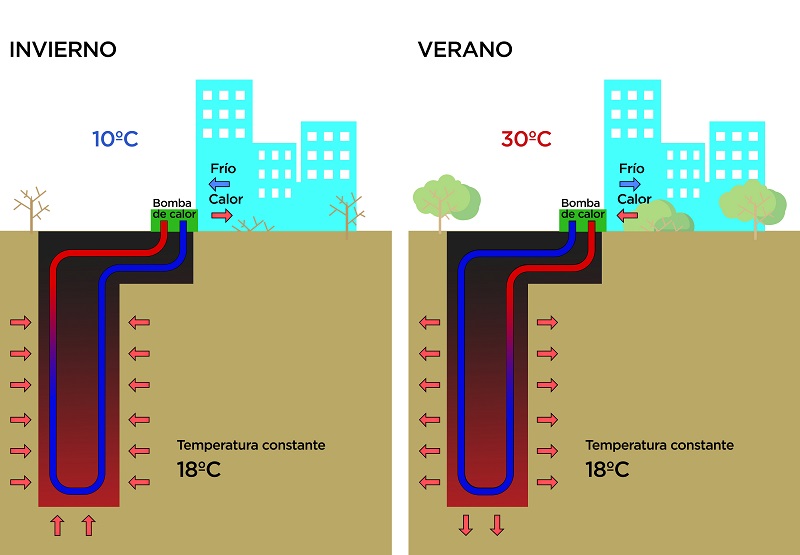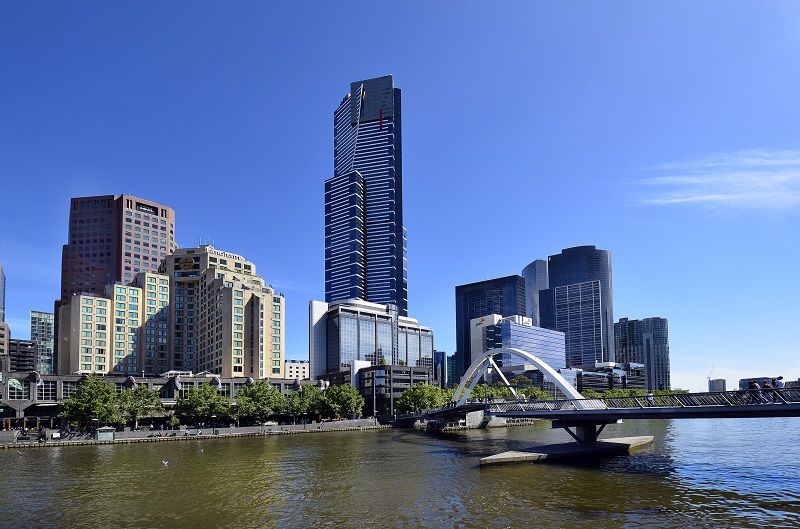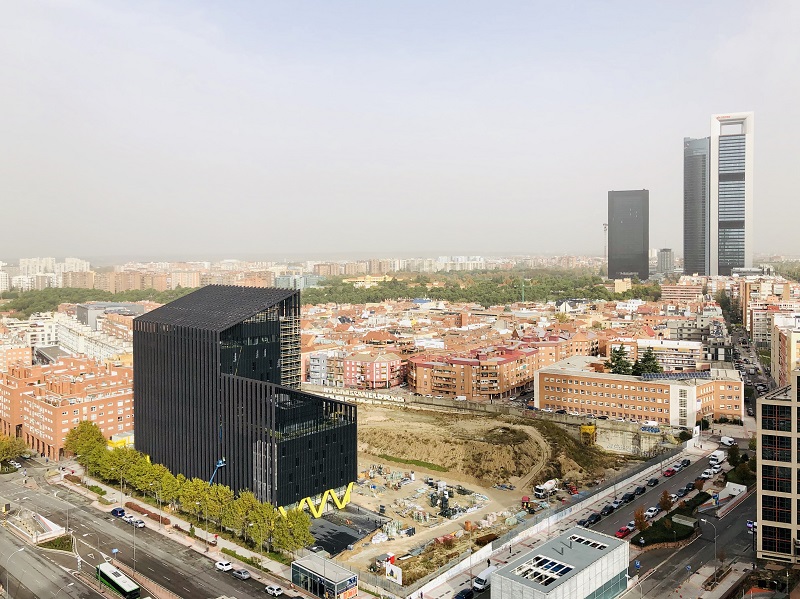19 November 2020
for Madrid Nuevo Norte

A great treasure lies beneath our feet that we cannot see and have yet to exploit. Even in the bitter cold of winter, just a few dozen metres below our houses, the temperature remains stable. This represents an as-yet unexploited opportunity to harness clean energy. Geothermal power and the techniques to extract and use the constant temperature to heat buildings is viewed as one of the most efficient and sustainable energy sources.
Although the energy from within the Earth occurs naturally from the dawn of time, in particular in hot springs, volcanoes and geysers, it was in the 20th century when its use grew exponentially, especially in recent decades in Northern Europe and North America. This model was first used in climate-controlled single-family homes. A few years later, it was extended to housing blocks, and now, it is seen as an opportunity for district heating systems.
Although geothermal energy is a branch of geophysics, the science that studies the thermal conditions of the Earth, the term has become commonplace owing to one of its more practical uses, which transforms the heat from within the Earth into a source of energy. An energy that can be used in industrial processes and for generating electricity. However, the most promising use is to create climate-controlled buildings. An area that will see further development in the coming years.

Flowchart of shallow geothermal energy for climate-controlled buildings
José Antonio Ferrer Tevar, the researcher responsible for CIEMAT’s Energy Efficiency in Buildings Unit, explains that geothermal energy used to heat buildings or districts must not be confused with deep geothermal energy, which is found hundreds of metres deep in the subsoil at temperatures over 150 degrees. This type of geothermal energy is extracted by large power plants to produce electricity and is usually used for industrial purposes.
Meanwhile, the so-called shallow geothermal energy, (also known as very low-temperature energy) refers to the energy found in the upper few metres below the surface with temperatures below 30 degrees Celsius. This source of energy is increasingly used for climate-controlling houses and offices. It may be potentially extended to other types of buildings, including transport infrastructures, shopping centres, schools and museums.
“We are using the energy stored in the subsoil,” said Ferrer. “It is a large mass of thermal inertia that, at these depths, is not produced so much by the Earth’s core as it is by solar energy absorbed by the soil that remains at a constant temperature year-round at a depth of three and a half metres.”

A heat pump is used to harness this constant subsoil temperature and bring it to the surface. Ferrer explained in simple terms its operation, based on the principles of thermodynamics: “It is a system that transfers heat from one place to another using a small amount of energy, typically electricity”. This heat exchange occurs in both directions, which is why it serves to both heat a space or cool it in summer when it is extracted, and the surface temperature is higher than that of the subsoil.
This is where shallow geothermal energy is the most efficient. “Let us imagine that I want to heat my house to 22 degrees in winter, and it is five degrees below zero. The leap from -5ºC to 22ºC is enormous and requires significant energy consumption”. With other energy sources, this effort would be “much greater than with geothermal energy, which allows me to work with a resource that has a constant temperature of, for instance, 16ºC”, Ferrer added.
When we talk about geothermal energy, we are not talking about the future, but rather a reality present in more and more buildings. “This is a standard solution for residential units, both single-family houses and blocks of flats,” explained Ferrer. “It is a very mature technology proven at a commercial level, although, of course, it is continuously enhanced, like all others”, added the expert.
It should be pointed out that geothermal energy alone is not the solution to all the energy challenges of buildings. It must be integrated into a new way of understanding and designing buildings, in which variables such as orientation, insulation and window layout also play an essential role. “The building’s design reduces energy demand, making geothermal and other energy solutions viable”, clarifies Ferrer.

The 297-metre tall Eureka Towers in Melbourne was the tallest residential skyscraper in the world in 2006, when it was built. The mammoth building uses geothermal energy to climate control its 91 residential floors.
Geothermal energy is present in construction milestones such as the Eureka Tower, a unique residential skyscraper in the Australian city of Melbourne or Zurich Airport in Switzerland. Various Spanish institutions committed to this trend, including the Faculty of Industrial Engineers at the Polytechnic University of Valencia (UPV), the Madrid Convention Centre (Ifema) or the new Comprehensive Transportation Hub, the future headquarters of Metro de Madrid and the Transport Consortium, currently under construction next to Plaza de Castilla. Private initiatives within our circles are also incorporating this system, including corporate headquarters and commercial buildings such as the Canalejas Centre next to Puerta del Sol.
Aside from the unique buildings and institutions that have opted for geothermal energy, countless other new residential buildings are committed to energy efficiency and environmental sustainability. Noteworthy amongst these is Arroyo Bodonal SCM, which won the award for the best geothermal facility in a private building in 2016, granted by the Regional Ministry of Industry and Economy of the Community of Madrid. These initiatives are increasingly commonplace in residential buildings. We must not forget that geothermal heat exchange systems in residential buildings can save 40% to 70% in the energy bill, according to the Spanish Geothermal Technology Platform (Geoplat), responsible to the Ministry of Science, Innovation and Universities.

Madrid’s future Comprehensive Transport Hub, next to Plaza de Castilla, incorporates geothermal energy into its facilities. Image: Comprehensive Transport Hub (CIT)
Experiences such as those taking place in Arcueil and Gentilly, in the southern Paris, have already met 60% of climate control demand through this cost-effective and clean solution, setting out the groundwork for the next milestone in mainstreaming geothermal energy into urban planning. The challenge now is to go one step further and introduce this energy into neighbourhoods and cities on a large scale. These district-level geothermal heat exchange systems will bring “highly efficient solutions that will play a pivotal role in meeting energy supply and demand in cities transitioning towards sustainable energy sources,” according to the Geoplat platform.
A leap towards a geothermal-powered city which international bodies such as the European Geothermal Energy Council (EGEC) support through various initiatives that promote district heating. According to this institution, over 25% of the European population lives in areas suitable for geothermal-powered urban climate control networks.
The cities most committed to sustainability are gradually moving towards an urban climate control model that combines different clean energies, including geothermal, wind, solar and biomass. The concept of district heating is not unlike a shared telecommunications network. Various sources of sustainable energy are channelled through shared conduits to provide heating or cooling.
Although the system could be incorporated into existing cities, new projects such as Madrid Nuevo Norte are viewed as a unique opportunity to ensure seamless integration of these infrastructures, enabling a giant step forward towards zero-emission cities.